

By Clément Miège
YAY! We made it to Kulusuk on Saturday afternoon! It ended being a not-too-long journey, since all of our flights were on time.
Rick, Ludo and I followed different itineraries. Rick left Salt Lake City on Friday morning and a red-eye flight took him to Keflavik International Airport in Iceland. He landed early Saturday and took a bus from the international airport to the domestic airport in Reykjavik (an hour-long ride).
Ludo came from a meeting in Switzerland and arrived in Iceland late Friday night. He stayed at a nearby hostel in Keflavik. The next day, he was told to take a bus that would take him to the domestic airport and that supposedly departs every hour in the morning. After waiting for a while, with no bus in sight, he walked back to town (carrying 2 duffel bags, a ski bag, and 2 carry-on bags) and learned his first Icelandic words: Saturday and Sunday (laugardaga og sunnudaga.) Turns out, during the weekend, the bus schedule is different. Good thing that taxis were not too far and that he ended up making it on time for his 12:45 pm Greenland flight!
Me, I had a one-day layover in Reykjavik, which was a nice chance to rest a bit and quickly visit the city. I walked around town, not for too long because it was definitely cold and windy and I am not yet acclimated to cold temperatures — but I will be in the next few days!
Reykjavik is a nice city… when it’s not too windy. The day I arrived, the wind was gusting and it was just too cold. But I still went on a walk to check the Hallgrímskirkja church. This is the largest church in Iceland, an amazing structure! Inside, there is a lift, making the church a pretty sweet observation tower with nice views over the city.
[Note: Originally in this post, I erroneously said Halgrímskirja is a cathedral. Thanks to our reader Harry McKone for spotting the mistake!]
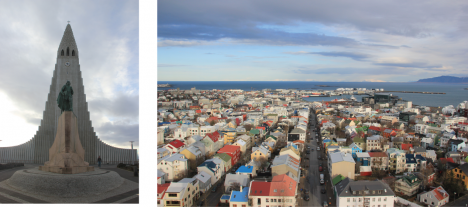
On the left, the church with the statue of Icelandic explorer Leif Eriksson. This story explains the first discovery of North America by a Viking expedition, led by Leif Eriksson about 500 years before Columbus: http://www.history.com/news/the-viking-explorer-who-beat-columbus-to-america. On the right, downtown Reykjavik, composed of colorful houses. (Credit: Clément Miège)
The next day, I joined Ludo and Rick at the domestic airport (they both arrived before me). Useless to say that we had a lot of gear between the 3 of us, a total of 6 carry-on bags (including laptops, radar computer, transmitters, GPS, etc.), 5 checked bags (with our cold weather gear), and 2 ski bags. We were a bit scared at first by Air Iceland’s policy of only allowing one 5kg carry-on and a 20kg checked bag per person, but we ended up getting through easily, which was a relief!
The flight was smooth and fast, only 2 hours to get to Greenland. Approaching Greenland, we started to see more and more winter sea ice along with some big icebergs trapped within it, which is always very pretty. The first islands finally appeared and we were about to land on one of them, where the little town of Kulusuk is.
Interestingly, the sea ice in the fjord next to Kulusuk seemed weaker and it might be thinner this year than when we visited last year. Ludo noticed some spots that were already ice free (see the photo below); those spots were covered by sea ice last April. The wind redistribution of the sea ice and the warm temperature in Kulusuk in January might be the reasons for this weaker sea ice pack.
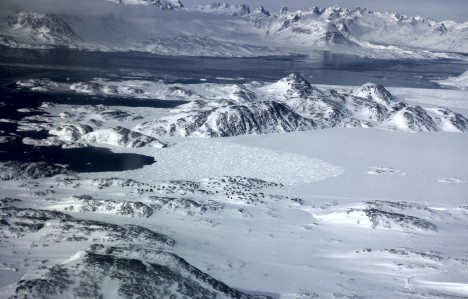
View from the plane of the sea ice around Kulusuk (the little black dots are houses.) (Credit: Ludovic Brucker)
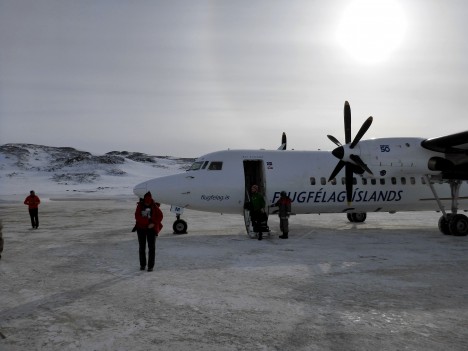
Our plane, freshly landed at the Kulusuk airport, with a faint sun halo in the background. (Credit: Rick Foster)
Shortly after landing, we made it to our hotel, and started to unpack. This year, Ludo and I brought back country skis, which is a really nice and fun improvement, and also a faster way to get from the hotel to the airport, or to go to the old garage where some equipment is stored from last year.
At the airport warehouse, we found all the equipment that we sent from the U.S. We counted the boxes and, great news, everything had made it her, and was in pretty good shape too! We started to unpack some items and took some of them to the hotel for re-organizing them some more.

At the Kulusuk airport, Ludo moves equipment around to consolidate our cargo (left). Some equipment is ready to be loaded on the helicopter (right) to go to our field site, but other gear needs some repacking, which will be one of our main tasks for the coming days. (Credit: Clément Miège.)
Today, a big storm is here and it’s a white-out outside — crazy, brrrrr! It is snowing horizontally. So happy we are not in the field right now! It is really windy this morning, about 37 mph, so we have decided to work indoors. We have couple projects: preparing antenna tubing for the low-frequency radar, preparing the radar sleds, assembling the ARGOS antenna pole, and starting to pull out the equipment from our last year’s storage place.
I can’t take any photos today, since it’s just white everywhere and impossible to see the surrounding buildings.
We are still on track for leaving this Thursday (March 27) to go to our camp site on the ice sheet. Amazingly, the only day of the week that looks good for flying out is Thursday — see the forecast below. That is lucky for us!
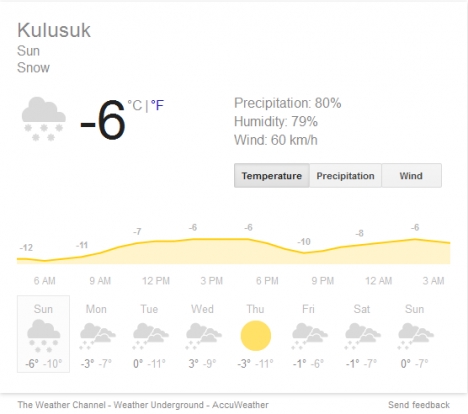
According to the Weather Channel, the only day with good weather this week is Thursday — good thing we are scheduled to leave then!
I’ll send a new blog post in a few days, stay tuned!
By Clément Miège
Hi there! I am Clément Miège, a Ph.D. student at the University of Utah and I am going to take you along with us to our second expedition to the southeast region of Greenland, to investigate the physical properties of a firn aquifer. And what is a firn aquifer, you might be wondering? It’s a reservoir of perennial water (that is, water that doesn’t freeze in the winter) that is trapped within the compacted snow layer (or firn) of the Greenland ice sheet. If you didn’t follow last year’s edition of this expedition and/or you want to learn more about the firn aquifer, here are some readings I recommend:
We are now getting ready for another expedition to Greenland to further monitor the firn aquifer. This year, our four main tasks will be to maintain our equipment currently in place (which performs temperature measurements), collect additional measurements (with a radar), install a weather station, and try traditional ground-water techniques to date the water and calculate its permeability. I will explain in future blog posts why these measurements are important.
I will be part of a smaller team this year, since only three out of the five members of the first-year team are joining. Rick Forster and I will represent the University of Utah, while Ludovic Brucker comes from NASA Goddard Space Flight Center.
Here is the photo of the team from last year, from left to right; Jay, Ludo, Rick, Lora and I. Lora and Jay won’t be coming to the field this year (we sure will miss them!) If you want to know a bit more about each team member (current and former), you can check this blog post from last year.
Even when we haven’t set a foot in the field yet, the expedition to Greenland started about two months ago with organizing the logistics. Logistics can sometimes be underestimated, but it takes a lot of effort prior to getting to the field to prepare and test the scientific equipment and other field supplies, such as camping gear, food, and power sources.
For this expedition, all of the science equipment (GPS, radars with different frequencies — 5MHz to 400MHz–, piezometers, ice-core drill) was gathered from different institutions in Utah to be packed here and shipped to Kulusuk. Most of the non-perishable food and camping gear was left for over-winter storage after last year’s expedition in a warehouse in Kulusuk, to save on shipping costs.
On March 3 this year, the Utah gear left for Greenland; we’re talking about 800 lbs. of gear that left Salt Lake City on a truck headed to the JFK airport in New York, where it was flown to Reykjavik (Iceland) and then to Kulusuk (Greenland). We got a phone call early this week from our shipping company to confirm that all our equipment made it to Greenland — great news!
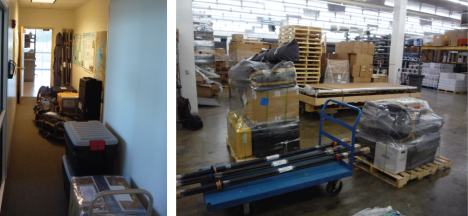
Gear packed at the office (left) and ready to leave the shipping facility at the University of Utah (right). We will see this gear again in Greenland!
These last days have been really busy, gathering the last items for our science research, and also personal equipment. Yesterday, I was working at Blue System Integration in Vancouver, BC with a colleague, Laurent Mingo, who is developing IceRadar, an ice-penetrating radar system for the scientific community (see this website for additional info). Laurent has been working on an experimental beta version of the current radar that will allow us to penetrate through the firn aquifer to try to image the bottom of the aquifer gradually transitioning from water-saturated firn to ice.
Even if most of the scientific equipment is already shipped, there are always some last-minute important items that we end up adding into our suitcases (like the low-frequency radar). As a brief anecdote, last year, Rick traveled with a pelican case as a checked bag – inside, there was a bunch of wires hooked up to a datalogger. We were aware that it looked kind of suspicious, so it was a bit scary to go through customs with it! Me, I traveled with a 60-meter long thermistor string weighing over 50 lbs. in my checked bag, because the fabrication and calibration took longer than expected and we weren’t able to ship it ahead of time with the rest of the equipment. This year, luckily, most of the heavy equipment was ready on time and we are carrying only a couple random items in our checked bags.
We are starting our journey this week, leaving the U.S. on Thursday evening for Reykjavik, the capital of Iceland. After a day in Reykjavik, we will leave mid-Saturday on a 2-hour short flight that will take us to Kulusuk, Greenland. We are hoping for good weather; last year, Ludo and I “boomeranged” on our first try due to poor visibility at the Kulusuk runway.
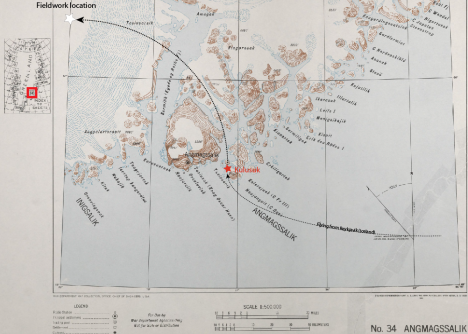
In this old map from the US army (from 1941) you can see the location of the small city of Kulusuk in Southeast Greenland (red star), just below the Arctic Circle (~66.5°N). Our field camp on the ice sheet is represented by a white star. The map can be found at the Polar Geospatial Center.
Kulusuk is our first stop in Greenland. We will be staying at this small village for a few days in order to re-pack our field gear, test that everything is working well (stoves, generators, tents, science equipment, etc.) before going to the field. If we are lucky, we might see one of the polar bears that sometimes come close to town in this time of year.
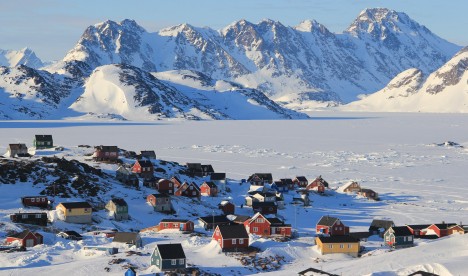
Colorful houses make up the town of Kulusuk in Southeast Greenland. The shores of the fjord are covered by sea ice in the winter.
After a couple of days, we will be heading to our fieldwork location on the ice sheet. A helicopter from Air Greenland will drop us and our cargo at our study site; it will be an about 45-minute commute.
That is it for this introduction; our next blog post will be from Greenland!
All the best,
Clément
In early September, I drove down to Wallops Flight Facility to set up our GPS base station in preparation for the test flight. The test flight is to verify that everything is working as expected, and to do some calibration, since the C-130 is a new platform for the Land, Vegetation, and Ice Sensor (LVIS). LVIS gathers data by sending out short laser beam pulses that bounce off the ground and give us the elevation of the terrain. Calibration ensures that we can pinpoint to within an inch where the laser hits the ground. We need to know exactly where the instrument is, and what it is seeing on the ground.
We use GPS receivers both on the ground and in the plane to track the position of the instrument. That’s where I come in. I set up the GPS ground station, which consists of GPS receivers and an antenna. In the field we usually get a rundown shack and we have to set up our own antenna. The Wallops GPS building was luxurious in comparison. It was spacious, air-conditioned, and had a permanent antenna built in, which meant I didn’t have to set up a tripod. I hooked up three ground receivers to the antenna, verified that they were working and started recording data. We do this for up to five days, in order to calculate precisely the location of the ground antenna.
I also tested the GPS antenna on the plane. It’s a different model from the ground antenna and is bolted to the top of the plane. A cable runs down from it so we can hook up the receivers. Just like for the ground receivers, I verify that they are working and recording data correctly.
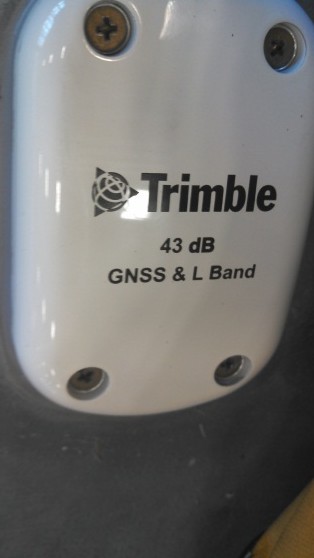
GPS antenna aboard the C-130
The C-130 is a rugged cargo plane. One of our instrument racks, filled with equipment necessary to operate LVIS, was sitting on the hangar floor outside the plane, waiting to be moved into place and bolted down. I got a look at the current state of the in-flight facilities and took pictures for the team back home. There had been much discussion on the subject since some of our flights may last up to 10 hours. We never imagined we’d be discussing these issues when we were in school! It’s all part of the field work experience.
At the end of the day, I collected and verified the GPS data available and left the ground receivers running. Everything was working as expected, so it was time for me to make the three hour trek back home. No traffic and beautiful scenery made for a pleasant drive.
Editor’s note: In fall 2013, researchers aboard a NASA C-130 traveled to Greenland to study changes in the ice sheet and sea ice following the summer melt season. Other airborne campaigns, like NASA’s Operation IceBridge, study changes on an annual basis and this is the first large-scale airborne survey of seasonal change. The C-130, equipped with a pair of Land, Vegetation and Ice Sensor (LVIS) laser altimeters, will carry out surveys of land and sea ice from Oct. 31 to mid-November and will resurvey many of the same areas flown by IceBridge during its 2013 Arctic campaign.
In late August, David Rabine and I headed down to Wallops Flight Facility in Virginia to start LVIS instrument installation for NASA’s Greenland airborne campaign.
It was my first time at Wallops and I was thoroughly impressed with the amount of airborne activity that takes place there. It seems like every 15 minutes there is a plane taking off or landing! Once there we saw the C-130 that will carry our two LVIS instruments. It looks like a great platform for scientific measurement. It has a huge cargo door in the back that allowed us to literally roll the pallet with all the equipment and the two instruments on board.

NASA’s C-130 aircraft on the tarmac at Wallops Flight Facility in Virginia. Members of the LVIS instrument team are installing equipment in preparation for the upcoming IceBridge Greenland campaign.
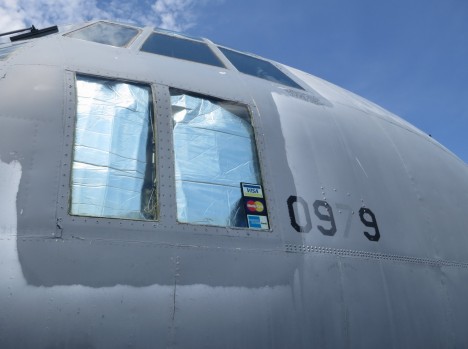
: The C-130 also had a sticker with major credit card logos on one of its windows. Perhaps this means they accept them for the in-flight entertainment.
Another benefit of the C-130 is the space available inside, which allows us to use four equipment racks without having to worry about space, and put the two LVIS instruments side-by-side. This will let us build a great data product. We spent a week populating our equipment racks, and by the end of it we had most of the equipment for the regular LVIS instrument mounted into its appropriate rack. Next came the equipment for the Global Hawk version and after finishing the equipment racks, we installed the two LVIS instruments onto a custom built platform that holds them in place.
We were very fortunate that our trip to Wallops lined up with a test flight of one of NASA’s Global Hawks, an uninhabited aerial vehicle that’s taking part in another NASA mission, the Hurricanes and Severe Storms Sentinel, or HS3, mission, and which the smaller version of LVIS has flown on before. As luck would have it, on the morning of Aug. 20 the Global Hawk took off on the runway that was closest to our airplane hangar. We were able to get a front seat view of the takeoff.
By Clément Miège
Hi there! Today I have another story to share with you! It’s about the tracking of the temperature evolution of the firn aquifer temperature by using two thermistor strings that we set up in the two holes made by Jay (see Jay’s post on drilling for details).
By tracking temperatures over a year, we will observe the firn heating mechanisms in the summer with the melt from the surface of the ice followed by water infiltration in the firn. In the winter, we will get a sense of the refreezing processes from the cold surface air, which cools the upper part of the firn and we will observe the persistence of the firn aquifer over the years.
To achieve this, we installed two thermistor strings with two different lengths: 30 and 60 meters. The shorter string has 60 sensors on it, sampling every half-meter. The longer one will only get a temperature reading every 2.5 meters but it will record deeper temperatures. Both strings are set to collect data every hour for an entire year, assuming the batteries last that long (hopefully!) The temperature chain is called a thermistor string because each sensor is a thermistor, a type of resistor sensitive to temperature changes. After measuring a resistance change, calibration curves allow us to retrieve temperature changes.
The thermistor-string story started in Utah, when we received the equipment late from the manufacturers, giving us only 5 days to work on it before leaving for Greenland. We realized that integrating the whole system together with the satellite uplink would take most of our last prep days.
It was definitely too late to ship the thermistor equipment with the rest of our gear, so Rick and I traveled with it in our checked luggage! I ended up with a 50 lbs of spool coiled with about 60 meters of cable in a suitcase. Rick had a black pelican case as his checked bag, with the second thermistor string, datalogger, ARGOS antenna and other pieces of hardware. We learned how to travel light, bringing minimal clothing, and wearing the cold-weather clothes in the airplane so we were able to meet the airline luggage restrictions – it definitely made for fun travels!
At the Kulusuk Hotel, in southeast Greenland, we finished integrating the thermistor string, mostly by picking the right data-transmission rate to the satellite in regards to our battery consumption estimates. Having the ARGOS satellite uplink will let us receive temperature data via email every day from the field site and tell us almost in real time what the temperatures are in the two holes.
In the field, shortly after drilling each hole (to avoid water refreezing due to cold air down the hole), we lowered the thermistor string down and backfilled the hole with surface snow. Then, we used the Felics drill to make a 4-meter hole to anchor the long pole that holds the ARGOS antenna.
On that day, the 20-knot katabic winds were blowing a lot of snow, so we used a mountain tent as a snow-proof environment to work with the electronics before dropping off the case in its hole. To give you a taste of the wind speed: Rick was charging one of the thermistor-string battery and the wind was so strong that it blew the small 1kw generator off…. crazy! When the winds finally died down, we buried the case in a 2-meter deep snow pit, because we wanted to prevent the case from being exposed to surface densification and melt during the summer.
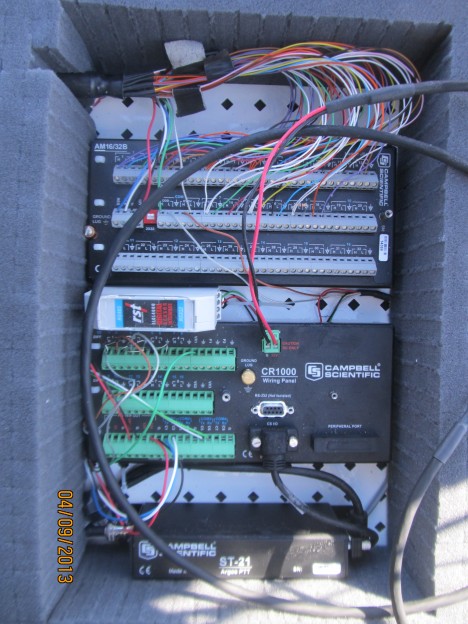
Last check on the electronics, to make sure all the wires are tightened before closing the box — next opening in one year!

After backfilling the snow pit, the only evidence at the surface of the temperature strings is the top of the pole with the ARGOS antenna and a red flag!
We are hoping to recover the case with the datalogger next year, but we are not sure if the ARGOS antenna will still be sticking out, because this sector of the ice sheet is getting a lot of snow accumulation in the winter. We will use a metal detector to find the metal pipes left near the case.
Because this is likely my last post for this expedition’s blog, I would like to thank the all team for this great adventure and everybody that was supporting this exciting research. Until next time!